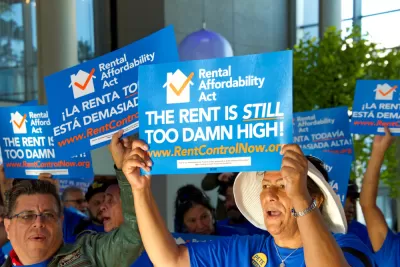California voters, with a reputation for liberal politics, have repeatedly refused to approve statewide rent control laws at the ballot box.

Liam Dillon performs a post-mortem on Proposition 21, a ballot initiative that would have implemented rent control statewide, but failed by a decisive margin to win voters in the state of California.
Proposition 21 was intended to be a more palatable version of Proposition 10, which also failed with California voters in 2018, but the changes weren't enough to win over the state's liberal voting base. As noted by Dillon, neither Proposition 21 nor Proposition 10 would have actually implemented rent control. "Instead, both initiatives would have done away with or changed current statewide prohibitions on most strict versions of rent control, which would have allowed cities and counties to pass their own measures later on," writes Dillon. So, the ballot initiatives would have removed the state preemption on rent control laws, granting cities control to determine their own, tailored version of rent control.
As for why Proposition 21 followed in Proposition 10's footsteps, Dillon collects responses from both supporters and opponents of the proposition for lessons in why rent control is so hard for a liberal state's voters to get behind. Here's Dillon's summary of the political headwinds facing rent control in the state:
Landlord groups significantly outspent the measures’ advocates, allowing the campaigns against the initiatives to hammer home with voters potential problems with rent control. And Democratic politicians and traditionally left-leaning interest groups such as labor unions have been split on the issue. Notably, Gov. Gavin Newsom didn’t support either rent control initiative, arguing this year that Proposition 21 would hurt the supply of affordable housing and detract from already available tenant protections.
According to experts cited in the article, outspending your opponents is a formula for success in the state's ballot initiatives process (see also: Uber, Lyft, and DoorDash's big victory on Proposition 22 during the same election).
But rent control opponents also have research to call on that rent control reduces the market incentives to develop new housing supply, leading to overall decline in affordable housing while protecting affordable housing for some residents.
Dillon also notes that despite these setbacks at the ballot box, the state has legislated new tenant protections in recent years, like a law signed by Gov. Newsom in 2019 that "caps annual rent increases at 5% plus inflation in most rental housing more than 15 years old, a bid to eliminate massive rent hikes that have forced people from their homes," according to Dillon.
FULL STORY: Why liberal California keeps saying no to rent control

Study: Maui’s Plan to Convert Vacation Rentals to Long-Term Housing Could Cause Nearly $1 Billion Economic Loss
The plan would reduce visitor accommodation by 25% resulting in 1,900 jobs lost.

Alabama: Trump Terminates Settlements for Black Communities Harmed By Raw Sewage
Trump deemed the landmark civil rights agreement “illegal DEI and environmental justice policy.”

Why Should We Subsidize Public Transportation?
Many public transit agencies face financial stress due to rising costs, declining fare revenue, and declining subsidies. Transit advocates must provide a strong business case for increasing public transit funding.

Paris Bike Boom Leads to Steep Drop in Air Pollution
The French city’s air quality has improved dramatically in the past 20 years, coinciding with a growth in cycling.

Why Housing Costs More to Build in California Than in Texas
Hard costs like labor and materials combined with ‘soft’ costs such as permitting make building in the San Francisco Bay Area almost three times as costly as in Texas cities.

San Diego County Sees a Rise in Urban Coyotes
San Diego County experiences a rise in urban coyotes, as sightings become prevalent throughout its urban neighbourhoods and surrounding areas.
Urban Design for Planners 1: Software Tools
This six-course series explores essential urban design concepts using open source software and equips planners with the tools they need to participate fully in the urban design process.
Planning for Universal Design
Learn the tools for implementing Universal Design in planning regulations.
Smith Gee Studio
Alamo Area Metropolitan Planning Organization
City of Santa Clarita
Institute for Housing and Urban Development Studies (IHS)
City of Grandview
Harvard GSD Executive Education
Toledo-Lucas County Plan Commissions
Salt Lake City
NYU Wagner Graduate School of Public Service





























